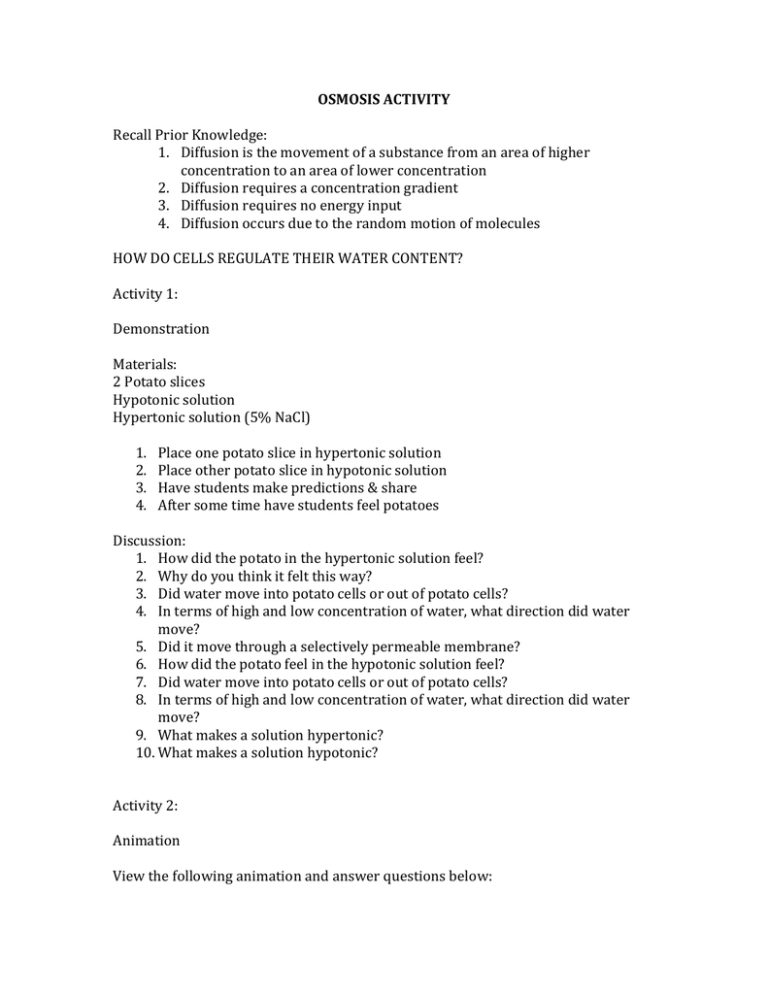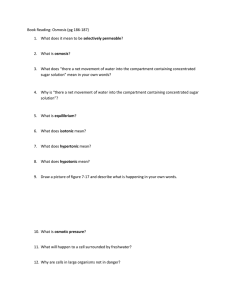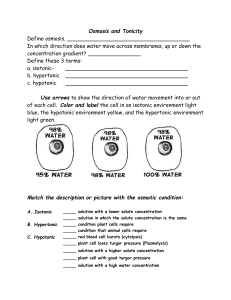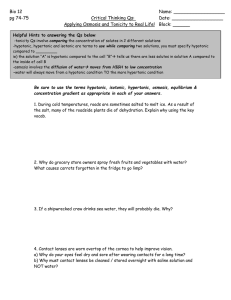OSMOSIS ACTIVITY Recall Prior Knowledge: Diffusion is the
advertisement

OSMOSIS ACTIVITY Recall Prior Knowledge: 1. Diffusion is the movement of a substance from an area of higher concentration to an area of lower concentration 2. Diffusion requires a concentration gradient 3. Diffusion requires no energy input 4. Diffusion occurs due to the random motion of molecules HOW DO CELLS REGULATE THEIR WATER CONTENT? Activity 1: Demonstration Materials: 2 Potato slices Hypotonic solution Hypertonic solution (5% NaCl) 1. 2. 3. 4. Place one potato slice in hypertonic solution Place other potato slice in hypotonic solution Have students make predictions & share After some time have students feel potatoes Discussion: 1. How did the potato in the hypertonic solution feel? 2. Why do you think it felt this way? 3. Did water move into potato cells or out of potato cells? 4. In terms of high and low concentration of water, what direction did water move? 5. Did it move through a selectively permeable membrane? 6. How did the potato feel in the hypotonic solution feel? 7. Did water move into potato cells or out of potato cells? 8. In terms of high and low concentration of water, what direction did water move? 9. What makes a solution hypertonic? 10. What makes a solution hypotonic? Activity 2: Animation View the following animation and answer questions below: http://www.glencoe.com/sites/common_assets/science/virtual_labs/LS03/LS03.ht ml 1. Does the hypotonic solution have more or less solute concentration than the cells? 2. Does the hypotonic solution have more or less water concentration than the cells? 3. Which direction does water move in a hypotonic solution, into cell or out of cell? 4. Does the hypertonic solution have more or less solute concentration than the cells? 5. Does the hypertonic solution have more or less water concentration than the cells? 6. Which direction does water move in a hypertonic solution, into cell or out of cell? 7. In an isotonic solution, what is the concentration of solutes and water compared to the inside of cell? 8. Which direction does water move in a isotonic solution? 9. What is the difference in how a plant cell responds and how an cell responds when placed in a hypertonic or hypotonic solution? 10. What environment is best for an animal cell? 11. What environment is best for a plant cell? 12. Will the animal cell burst if too much water enters cell? 13. Will the plant cell burst if too much water enters cell? 14. Will the animal cell shrivel if too much water leaves cell? 15. Will the plant cell shrivel if too much water leaves cell? 16. What determines how much water enters or leaves a cell? Class Discussion Activity 3: Osmosis Problem: Sequence for solving U-tube problem 1. Initially, which side is hypotonic? 2. Which side will water level raise? 3. Which side will have a greater number of glucose molecules after equilibrium has been reached? 4. Which side will have a higher concentration of glucose after equilibrium has been reached? 5. During the course of the experiment there will be a decrease in the concentration of NaCl on which side? Class discussion: Activity 4: Fill in class notes Activity 5: Check for understanding: Dispense quiz questions Discussion






